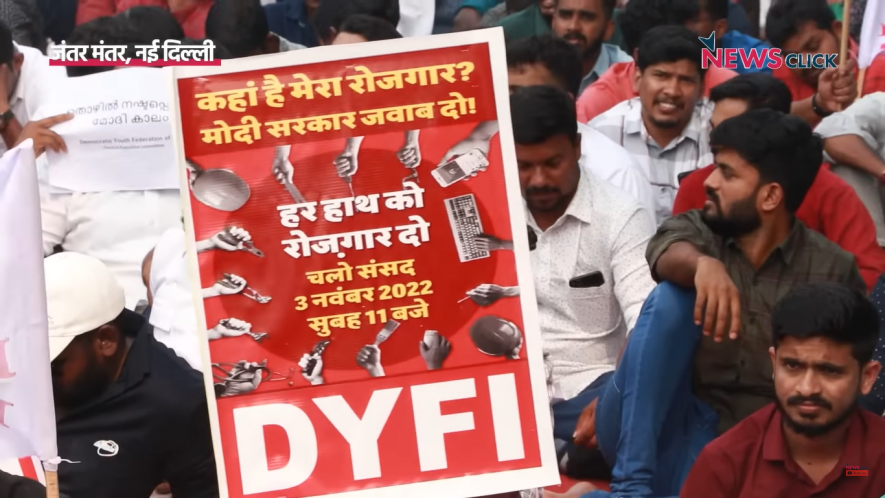Jobs in India: Gone With the Neoliberal Wind!

A youth organisation, DYFI, protested against rising unemployment in the country. (Nov 3, 2022. | File photo)
The data on unemployment brought out by the Centre for Monitoring the Indian Economy (CMIE) present a grim picture. Not only has the unemployment rate increased sharply for some years now, starting from even before the pandemic, but the figure which had shot up during the pandemic has not come down much despite the recovery that has occurred in the level of GDP (gross domestic product) from its trough.
The unemployment rate which was 4.7% in 2017-18, rose to 6.3% in 2018-19. It shot up during the lockdown associated with the pandemic: in December 2020, for instance, it was 9.1%. Since then, it has come down a little but not as much as one would have expected even from the truncated output recovery that we have experienced. It was 8.3% in December 2022, came down to 7.14% in January 2023, but has again climbed up to 7.8% in March, the latest month for which we have CMIE data.
The GDP recovery has been stunted, but the GDP estimate for 2022-23 is still supposed to be 8.4% higher than in 2019-20 and 12.95% than in 2018-19. Yet, despite GDP being 12.95% higher, the unemployment rate at the end of 2022-23 is higher at 7.8% compared with 6.3% for 2018-19. Since the workforce in these four years could not have increased by more than, or even as much as, 12.95%, the obvious conclusion is that employment per unit of GDP has come down between 2018-19 and 2022-23. This, in turn, could not have happened through any significant technical change being introduced within particular activities over such a short period.
Read Also: Unemployment Ravages Indian Economy But Resistance Mounts
One can infer, therefore, that the current higher unemployment rate compared with before the pandemic, can be attributed to the two following factors: one, that the recovery has occurred primarily in sectors and activities that are not employment-intensive; that is, the petty and small-scale sectors that are employment-intensive, have been left out of the ambit of the recovery. And, two, there have, of late, been significant lay-offs whether in response to reduced demand or in response to the imposition of “austerity”.
There is direct evidence provided by CMIE of such lay-offs. It estimates that the actual number of employees declined from 409.9 million in February to 407.6 million in March. Incidentally, in 2019-20, the total number of employed persons in India was 408.9 million, which means that the absolute number of persons employed in March 2023 was lower than in 2019-20. This is a grim scenario, where, let alone additional jobs being created to absorb additions to the workforce, the existing number of jobs itself has declined in absolute terms.
It is ironic in this context to come across government spokesmen claiming an improvement in the employment situation in the country. These spokesmen present two arguments: one, that the CMIE data are untrustworthy and are at variance with what the official Periodic Labour Force Surveys (PLFS) suggest, which is an improvement in the employment situation; and, two, the fact that the demand for employment under the MGNREGS (the rural job guarantee scheme) has gone down is also indicative of such an improvement.
Both these arguments, however, lack substance. A major difference between PLFS and CMIE data on employment is that the former includes unpaid work in domestic economic activities within the term employment, which the latter does not. But the problem with including unpaid work in domestic activities is that when there are lay-offs or reduced employment possibilities outside. In short, precisely when the family’s fortunes are taking a nosedive, and family members are being excluded from outside employment and forced to remain at home sharing whatever work is available within the household, PLFS will not show any increase in unemployment. It cannot, in other words, distinguish between enforced confinement to the home and gainful employment in domestic activities.
The CMIE is free of this shortcoming; and therefore, even though its exclusion of unpaid work in domestic activities means that one category of work, namely gainful employment in domestic activities, gets excluded, it has the merit of capturing in a consistent manner what exactly is happening to paid employment opportunities in the economy. And since these go down in a period of growing unemployment, the CMIE measure provides a reasonably accurate proxy for the overall unemployment scenario.
Likewise, the fact that there has been some return to towns of persons who had trudged to villages because of the enforced deprivation of both residence and incomes during the ill-thought-out lockdown associated with the pandemic, is not a matter of dispute.
Read Also: Lockdown Caused Prolonged Unemployment, Shift to Informal Work: Survey
A reduction in the massive burden that had fallen on the MGNREGS because of the lockdown, therefore, should come as no surprise. But while this may mean some reduction in the unemployment rate compared with the period of the lockdown, it does not deny either a rise in this rate compared with the pre-pandemic levels, or the fact of an altogether meagre decline of this rate compared to the lockdown period.
Besides, because of the wage arrears on MGNREGS that have built up because of the Central government’s unwillingness to make timely wage payments, the keenness even among the unemployed workers to seek work under this scheme has gone down somewhat. The demand for work under MGNREGS, therefore, has become a poor indicator of the magnitude of unemployment.
In fact, it is ironic that while the Union government delays wage payment to MGNREGS workers, leading to their unwillingness to offer themselves for employment under this scheme, this very fact of their unwillingness is then used by the same government to claim that the unemployment situation has improved!
Read Also: MGNREGA: Nearly 1.5 crore Job Seekers Refused Work Till Now
One normally expects unemployment figures to be correlated to the average real income figures for the working people as a whole, and even with the average real income of self-employed workers. This is because the self-employed group is where the reserve army of labour is typically concentrated, and a decline in employment, resulting in a rise in the proportion of the reserve army, would tend to lower the average real incomes in the self-employed sector. And it is interesting that the government’s own PLFS data show that the average real income of self-employed workers in the April-June quarter of 2022, for which we have data, while slightly higher than during the trough reached during the lockdown, was below its level during April-June 2019, both in rural and in urban India (Chandrasekhar and Ghosh, Macroscan). This only tends to confirm the CMIE findings on unemployment.
What India’s unemployment statistics reveal is something fundamental, namely, that neoliberal capitalism can never be the social arrangement that can overcome the problem of unemployment in our country. The votaries of “economic liberalisation” had sold the people of India a dummy. Since a certain degree of diffusion of economic activity had occurred from metropolitan capitalist economies to a few small countries of east and South-East Asia resulting in a significant using up of their comparatively small labour reserves, they argued that this strategy could be successfully replicated everywhere, that if only things were “left to the market” and the government withdrew from its interventionist role, except in favour of big capital, then India too would be on the road to “full employment” and prosperity.
Of course, a capitalist economy can never attain “full employment’, since it can never function without a reserve army of labour, but at least a substantial use of the labour reserves under neoliberalism was promised, which deceived even many progressive people. And the argument succeeded in “rolling back” the State that had come into being in Third World countries after decolonisation and that had adopted a relatively autonomous stance vis-à-vis metropolitan capital and imperialism in general.
There were two obvious fallacies with this argument: one, taking the Third World as a whole, the diffusion at the margin of some activities from the metropolis could not possibly use up its vast labour reserves; it might do so in some small countries with relatively small labour reserves, but not in countries like India with huge labour reserves.
Two, when neoliberal capitalism got into a crisis, as was inevitable with capitalism, there was no mechanism to bring this crisis to an end, in which case working people in countries, like India, that adopted a neoliberal regime, would be doomed to an endless period of suffering. What we are seeing today in India is only a vindication of this proposition.
Overcoming unemployment is not a matter of applying a few “fixes” to a regime of neoliberal capitalism. It is a matter of moving to a completely different socio-economic order that not only functions without a reserve army of labour, but that also permits conscious State intervention on behalf of the working people.
Get the latest reports & analysis with people's perspective on Protests, movements & deep analytical videos, discussions of the current affairs in your Telegram app. Subscribe to NewsClick's Telegram channel & get Real-Time updates on stories, as they get published on our website.
























